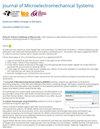模拟 MEMS 环形陀螺仪的温度效应:实现物理感知漂移补偿
IF 3.1
3区 工程技术
Q2 ENGINEERING, ELECTRICAL & ELECTRONIC
引用次数: 0
摘要
温度在MEMS陀螺仪的长期性能中起着不可或缺的作用,尽管在文献中进行了广泛的研究,但温度效应的分析处理仍然是一个悬而未决的问题。这篇论文,据我们所知,是第一次尝试解决这一差距的环形陀螺仪。我们从一个叠加原理开始,将热位移场从陀螺仪的标称振动中分离出来。我们提出了一个几何非线性变分公式来获得温度诱导刚度矩阵。我们在直径3.2毫米、58千赫的环形陀螺仪上进行温度测试,陀螺仪配备了16个电容性应力传感器。实验数据在以下几个关键方面验证了我们的分析模型:1)该模型不仅考虑了材料性能的变化,还考虑了一个较少探索的因素,即热应力。由于应变插值模块可以利用测量的应力,该模型可以一致地预测频率变化,并捕获由残余应力引起的滞后回路。值得注意的是,我们准确地估计了频率温度系数(TCF)与期望值- 30 ppm/°C的偏差(基于众所周知的硅的杨氏模量的- 60 ppm/°C依赖性)。2)该模型能够捕获小于0.1 N/m量级的刚度耦合(在7 kN/m的设备中),并能很好地预测正交误差及其向同相通道的泄漏。此外,该模型还考虑了机械比例因子、驱动模式振幅、阻尼耦合和感知模式相位对同相误差的贡献。基于这些优点,我们的模型可以作为包含温度效应的底层物理的漂移补偿算法的构建块。(2024 - 0163)本文章由计算机程序翻译,如有差异,请以英文原文为准。
Modeling Temperature Effects in a MEMS Ring Gyroscope: Toward Physics-Aware Drift Compensation
Temperature plays an indispensable role in the long-term performance of MEMS gyroscopes, and despite extensive studies in the literature, analytical treatment of temperature effects is still an open problem. This paper, to the best of our knowledge, is the first attempt to address this gap for ring gyroscopes. We start with a superposition principle that disentangles thermal displacement fields from the gyroscope’s nominal vibration. We set forth a geometrically nonlinear variational formulation to obtain the temperature-induced stiffness matrix. We conduct temperature tests on our 3.2 mm-diameter, 58 kHz ring gyroscopes equipped with 16 capacitive stress sensors. The experimental data validate our analytical modeling in the following key aspects: 1) The model accounts for not only changes in material properties but also a less explored factor, thermal stresses. Thanks to a strain interpolation module that leverages the measured stresses, the model predicts frequency variations consistently and captures hysteresis loops arising from residual stresses. Notably, we accurately estimate the deviation of the temperature coefficient of frequency (TCF) from the expected value −30 ppm/°C (based on the widely known −60 ppm/°C dependency of Young’s modulus of silicon). 2) The model is able to capture stiffness couplings in the orders of less than 0.1 N/m (in a 7 kN/m device) and closely predicts the quadrature error and its leakage into the in-phase channel. Additionally, the model incorporates temperature variations of mechanical scale factor, drive mode’s amplitude, damping coupling, and sense mode’s phase in terms of their contribution to the in-phase error. Based on these merits, our model serves as a building block toward drift compensation algorithms encompassing the underlying physics of the temperature effects. [2024-0163]
求助全文
通过发布文献求助,成功后即可免费获取论文全文。
去求助
来源期刊

Journal of Microelectromechanical Systems
工程技术-工程:电子与电气
CiteScore
6.20
自引率
7.40%
发文量
115
审稿时长
7.5 months
期刊介绍:
The topics of interest include, but are not limited to: devices ranging in size from microns to millimeters, IC-compatible fabrication techniques, other fabrication techniques, measurement of micro phenomena, theoretical results, new materials and designs, micro actuators, micro robots, micro batteries, bearings, wear, reliability, electrical interconnections, micro telemanipulation, and standards appropriate to MEMS. Application examples and application oriented devices in fluidics, optics, bio-medical engineering, etc., are also of central interest.
 求助内容:
求助内容: 应助结果提醒方式:
应助结果提醒方式:


